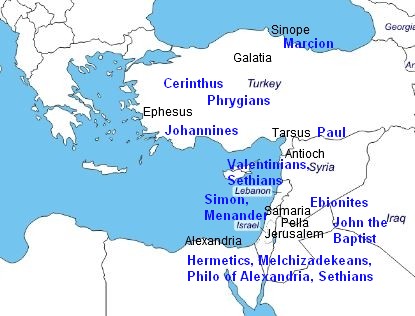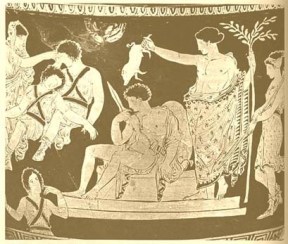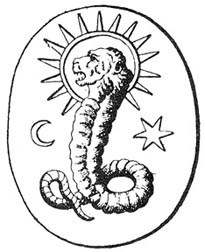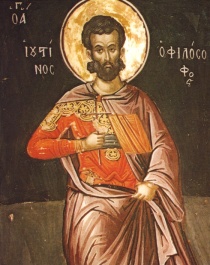The original core of my speculation about Christianity’s origins was that Alexandrian Gnosticism became Christianized via a series of social, political, and religious catalysts in the late 1st and early 2nd century, notably the Jewish-Roman and Bar Kokhba conflicts between 65 and 140, influenced by Philo of Alexandria‘s Hellenized interpretation of Judaism, notably the Greek notion of the Logos. It subsequently spread Northward via well-traveled Eastern Roman trade routes, finding hospitable epicenters in Syria and Roman Asia (Turkey) by the early 2nd century.

The central tenet of my former speculation was that it seemed implausible that a human Jesus could have lived around Lake Galilee in the 20s and 30s, yet found his origins in the Valentinian Pleroma and Kenoma 100 years later. As plenty of Jesus myth theorists can describe better than I can, Jesus did not live in the 20s or 30s; however, the original Jesus-on-Earth was based on a real person: Jesus ben Ananias, who was most active in the years leading up to the Jewish Roman war in the mid-60s, and died sometime between 65 and 70. This further complicates all notions within the traditional Jesus story, because, instead of the 100 years for Jesus to get from Galilee to the outer regions of the galaxy, it only took 50 or 60 years.
Many Jesus Mythicists would invoke Paul at this point in order to reconstruct a picture of Christianity’s trajectory and earliest geography, particularly if they assume the Pauline letters are representative of the earliest iteration of Christianity.
My impression of Paul, and who his likely author was*, makes him a much less reliable founder than others presume.
*There were obviously plenty of contributors to the Paul corpus. Candidates in my mind include the later Johannine Pastoral authors (perhaps Polycarp or Irenaeus), Marcion (Galatians), Cerinthus, Theodotus (Hebrews), and Valentinus.
I’ll stick a pin in the idea of Paul for a moment, and turn to another very early Christian text, the Gospel of Mark.
The first logical hurdle within this context focuses on whether the original Gospel writer (proto-Mark) knew Jesus ben Ananias, or had any connection to him at all. If Mark’s writer somehow inherited a theology concocted by Jesus ben Ananias, or a community which soon after came to “see the truth” of Jesus’ rantings, then we can place Christianity’s origins in Judea, and quit worrying about it.
The problem with such an assumption is that Mark’s author knew very little about Judean culture, notably that the Sanhedrin did not hold trials at night, that Jesus would not have traveled from Tyre to Galilee via Sidon (Mark 7:31), and that it was not actually a custom to release one prisoner (this is certainly not a tradition Pontius Pilate would have observed).
There is an additional detail which should amplify a tentative rejection that Christianity originated in Judea. This detail brings us back to Paul, and is encapsulated within Galatians 3:1:
You foolish Galatians! Who has bewitched you? Before your very eyes Jesus Christ was clearly portrayed as crucified.
Paul tells the north Turkey Galatians that Jesus was *portrayed* as crucified. In other words, Paul makes reference to depictions of Christ’s crucifixion, and that the Galatians clearly saw him being crucified. He did not say the Galatians had been to Judea (over 800 miles away), or that they witnessed the actual man Jesus being crucified. Jesus ben Ananias was not crucified. He died from either traumatic brain injuries or other boulder-related trauma. If we assume Galatians was written before 65 (I don’t think it was, but many do), then Paul’s entire career was spent propagating a different Jesus than the one Mark wrote about.
Yet, Paul clearly alludes to dramatic depictions of Jesus’ crucifixion. The intrigue here is that the Gospel of Mark follows conventions of Greco-Roman tragedies, including frequent and abrupt scene changes, narration as a literary device, and sparse dialogue – all attributes which lend themselves to dramatic depictions. Given the blatant references to underlying mysteries contained within these texts, not only in many of the Pauline letters (Rom 11:25, Rom 16:25, 1 Corin 15:51, 1 Corin 14:2, 1 Corin 2:7), but also in Mark itself (Mark 4:11), we see emerging similarities between Mark (and Paul) and other mystery cults, particularly the Lesser Eleusinian mysteries, which included yearly dramatic depictions of “the miseries of the soul while in subjection to the body”.
Mark 4:11-12
And He told them, “The mystery of the kingdom of God has been given to you, but to those on the outside, everything is expressed in parables,so that, ‘they may be ever seeing but never perceiving, and ever hearing but never understanding…
 Lesser Mystery Participants sacrificed a piglet to Demeter and Persephone (who was kidnapped and taken to Hell [Underworld] by Satan [Hades]). Participants then ritually purified themselves in the river Illisos in Athens, Greece. Completion of the Lesser Mysteries meant participants were deemed mystai (“initiates”) worthy of witnessing the Greater Mysteries. Ritual river cleansing (baptism) and animal sacrifice was a feature of initiation which preceded any subsequent learning.
Lesser Mystery Participants sacrificed a piglet to Demeter and Persephone (who was kidnapped and taken to Hell [Underworld] by Satan [Hades]). Participants then ritually purified themselves in the river Illisos in Athens, Greece. Completion of the Lesser Mysteries meant participants were deemed mystai (“initiates”) worthy of witnessing the Greater Mysteries. Ritual river cleansing (baptism) and animal sacrifice was a feature of initiation which preceded any subsequent learning.
A noteworthy detail in this parallel is that an underlying theme in the Gospel of Mark, which any Jewish Diaspora reader would have recognized, is the idea of a scapegoat. One goat was sacrificed at the altar, while another goat was sent into the wilderness. Jesus serves both functions in the Gospel of Mark – he was sent into the wild to battle Satan for 40 days in Mark 1:4, and he became the sacrifice when he was crucified.
My point in referencing these links is to point out that Christian authors did not need to be from Judea; in fact, it is more plausible that they were not. If we assume the Mark’s original author was an inheritor of Paul’s theology (see Mark 9:38-39), then what we see is a continuation of a tradition which borrowed from other mysteries of the day, integrating it into a new post-messiah Judaism. If we follow convention dating for Paul, we subsequently place Paul as the earliest Christian, who admittedly never met the man Jesus – Paul adamantly defended his Christianity by claiming interactions with Jesus came via spiritual revelation, rather than face-to-face interaction (Galatians 1:12, 1 Corinthians 15:3-8).
Though Paul never made a claim about his own origins in his authentic epistles, his hometown is placed in Tarsus, which is in Southern Roman Asia (Turkey).
Roman Asia is a convenient starting place for Christianity’s origins, because it is approximately in the middle between Greece (Eleusinian mysteries) and Jerusalem (Judaism). It is also close to Syria, which is a plausible starting point for the later-integrated Gnosticism.
 The consistently manifesting theme within early Christianity is that the earliest authors borrowed heavily from Josephus. Revelation and the Gospel of Mark borrow word-for-word at points; the specific Josephus book from which both these texts borrow is Wars of the Jews, specifically, from Josephus’ description of Jesus ben Ananias and the temple before it was destroyed. In fact, given Revelation’s references to talent-sized boulders being hurled through the air, and the fact that Jesus ben Ananias was killed by one of these boulders, it stands to reason that the authors of Mark and Revelation were aware of the same underlying Christian traditions; the more important detail is that they both used Josephus as their encryption key to encode their mysteries.
The consistently manifesting theme within early Christianity is that the earliest authors borrowed heavily from Josephus. Revelation and the Gospel of Mark borrow word-for-word at points; the specific Josephus book from which both these texts borrow is Wars of the Jews, specifically, from Josephus’ description of Jesus ben Ananias and the temple before it was destroyed. In fact, given Revelation’s references to talent-sized boulders being hurled through the air, and the fact that Jesus ben Ananias was killed by one of these boulders, it stands to reason that the authors of Mark and Revelation were aware of the same underlying Christian traditions; the more important detail is that they both used Josephus as their encryption key to encode their mysteries.
Josephus wrote Wars of the Jews around 75. This detail debunks the notion that Mark was written in or before 70. It also disproves that Revelation (at least the parts which reference the war) was written before 75, as well (most people assume Revelation was >90 anyway). As I mentioned earlier, this timeline also truncates the amount of time the Valentinian Gnostics had to convert the Judean minister into a pre-existing Aeon-turned-human, down to 50 or 60 years.
If we presume the Sethians (at least their Gnostic tenets) preceded the Valentinians, the timeline becomes even more truncated, especially if one is attached to the notion that the Alexandrian Sethians became Christianized in the 1st century CE.
One solution, and the one I believed for nearly a year, is that the Sethians invented Christianity. There are several problems this hypothesis solves, including why the earliest Sethian texts were seemingly unaware of Marcion’s favorite apostle, Paul.
When this matrix is coupled with the fact the Sethians were in Alexandria in the late 1st century, and that Philo of Alexandria wrote a Logos-based prototype for later Johannine texts (featuring the Apostle John) in the mid 1st century, Alexandria becomes a tempting location for Christianity’s earliest formulation, and I personally would not hold it against anyone for assuming this.
However, there are several details which lead me to believe Alexandria is not the single solution.
First, there is not strong evidence that the Sethians were Christianized in the first century. Birger Pearson and other eminent scholars have given a plausible location for the Sethians in Syria. In my mind, this opens up the notion that a Jewish-influenced Gnosticism, perhaps from Alexandria, worked its way north to Syria, and this was where Gnosticism met Christianity; perhaps it was Valentinus or his followers who interjected Valentinian Christianity into the Sethian system; in other words, there seems to have been a feedback loop between the Valentinians and the Sethians, and notably absent within this loop was Paul.
A second reason for my Alexandrian skepticism is that the earliest heretic I can find (who also seems to have plausibly existed) is Cerinthus. Cerinthus was said to have traveled between Ephesus in Western Roman Asia and Galatia in North-Central Turkey, and he is placed by Irenaeus and Epiphanius as being in the tail end of the apostolic era, precisely the time when Christianity was likely to have been catalyzed into something like what it became. Among other things, Cerinthus was said to have contributed authorship to Revelation, which (if true) would imply he was tapped into a similar tradition as Mark’s author was. Cerinthus, if my assumptions about him are correct, was also a heavy contributor to the earliest Johannine theology.
Another reason why I have become more skeptical of Alexandrian origins, and more open to Roman Asian origins is because much of the recoverable plausible Christian history (as opposed to the majority of Christian history, which is obviously fiction) centers around Asia. Notable examples include the Johannines, who were in western Turkey, Cerinthus who was in Galatia and Ephesus, Marcion who was in Northern Turkey, and the Phrygians, who were in Central Turkey. Another heretical, and oft-ignored sect, the Marcosians can also be located somewhere in Asia, according to Irenaeus who claimed Marcus seduced an Asiatic deacon’s wife (AH i.13). Given Marcion the Sinopean’s reverance to Paul, and his presumptive “discovery” of Paul’s letter to the Galatians (perhaps in Syria), Turkey becomes an increasingly likely candidate.

An internal detail within Christianity which ties these geographic locations together is the Demiurge concept. Most of the early heretics (notable exceptions were the Montanists and Ebionites) saw the Abrahamic God as a lower God who was responsible for the creation of the material world. The Marcionites, Valentinians, Sethians, Simoneans, and Basilideans all held this view, and most of them called him Yaldabaoth. My suspicion is that this “alien God” concept came from Gnosticism. The idea must have been appealing, given the fact that many 1st century Jews probably have felt abandoned by God via their Roman persecution, and that a parallel sect, the John the Baptist sect (the Mandaeans and/or the Nasoreans), also had a Demiurge concept which posited a God above the lower, inferior Gods.
In light of these details, my current formulation is that a Jewish-tinged Gnosticism moved northward from Alexandria to Syria. It was here that a disillusioned Hellenized Judaism, which would be the earliest iterations of a Docetic Christianity, integrated various components of that Gnosticism. This integration, via it’s complicated Demiurge concept, gave rise to a rejection of this blasphemy, and can be located in the Ebionite and later Montanist (Phrygian) heresies; these theologies can be roughly characterized as more Jewish and less Hellenized than the other sects. Those sects which held to the original theology, the Cerinthians and Marcionites, were also eventually expelled, and the void was filled by the likes of Justin Martyr, Polycarp, and Ignatius (whoever they were?).
The emerging Orthodoxy still had internal members who were open to other heretical

inputs. The most prominent example was Tatian, who was supposedly the author of the harmony Gospel, the Diatessaron. According to Irenaeus, Tatian was a student of Justin Martyr, and later became a Valentinian. In my mind, this Tatian mutiny is evidence that Valentinianism was a major component of the mid-2nd century pre-Orthodoxy, although others in Tatian’s circle, notably Justin Martyr, were fierce anti-Marcionites. This might suggest that there was a power struggle between Marcion’s simpler framework and Valentinus’ more complex myth, although Irenaeus claims Marcion went to Rome several years after Valentinus did. A solution to this curious chronology is that Clement of Alexandria writes that Marcion sprang up at the same time as the other heretics, despite being older than them. There is also something to be said for these heretics’ activities prior to their arrival in Rome; for example, if Marcion was from Sinope, and discovered Galatians in Syria, then he was obviously active in the faith prior to his arrival in Rome. Similarly, the Valentinians had a strong footprint between Syria and Alexandria for hundreds of years; there was a split between the Eastern and Western Valentinians which centered around, among other things, how human Jesus was.
Ultimately, it is difficult to pinpoint where Christianity’s origins were. There are several Mythicist positions which seem plausible. But in my mind, Cerinthus seems to be the fountainhead, as he fits several important criteria: he had a first generation Docetic theology (where the Jesus-man and the Christ were separable), he was placed in the apostolic era, and he receives polemical pushback, being linked with both John and Peter. Given all the other so-called heretical activity in Roman Asia, it becomes as plausible as any other geographic location proposed for Christianity’s origins.
But could it be that the very germinal stage of Christianity started in Alexandria that eventually spread out to Asia Minor where the Gnostic flourished? The four gospels didn’t used the Hebrew OT but rather the LXX/Septuagint to flesh out the messianic prophecies and characters. The Hebrew OT was translated to Greek in Alexandria, Egypt where in the Hebrew name Joshua/יֵשׁ֫וּעַ was transliterated to Jesus/ιησους. But I see where your coming from the out of turkey theory. Acts 11:26 says:
“…and when he had found him, he brought him to Antioch. For a whole year they met with the church, and taught a large company of people; and in Antioch the disciples were for the first time called Christians.” (emphasis added)
While this needs confirmation from other earlier manuscripts, the Codex Sinaiticus renders it as Chrestianou/χρηστιανου, not Christians/χριστιανου. People may say it’s just scribal glitch and it could be just a scribal glitch, but given the provenance of the this Codex in Alexandria, it could be possible that Christianity didn’t emerged from a single place alone . But that’s just my opinion.
LikeLiked by 1 person
I also think that the (physically) closer to Rome the ‘origins’ occurred, the more likely they were to be transmitted to Rome by returning soldiers and/or camp followers. These returning Roman ‘converts’ had two centuries to establish communities and eventually subsume/replace Mithraism & influence Constantine’s Mother (according to legend). Once established in the 4th century, burning the library in Alexandria was a ‘no brainer” in erasing evidence.
LikeLike
There definitely seems to have been a concerted effort to go to Rome – Justin Martyr, Polycarp, Marcion, Valentinus, etc…all went to Rome starting in the 130s. My suspicion is that the intent was a lobbying effort, as evidenced by an increasing number of apologies.
LikeLike